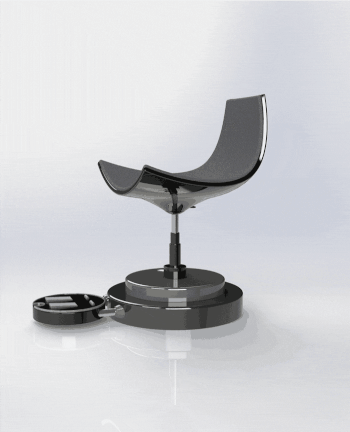Roto VR has recently launched a Kickstarter campaign for its rotating chair design that promises to reduce simulator induced nausea, and give the user more control inside the virtual environment without getting tangled up in wires.
Roto VR, a London based company, have built a novel take on the office swivel chair that aims to eliminate the most nauseating part of moving around in virtual environments: the dreaded yaw rotation, an unfortunately necessary part of traditional in-game locomotion that requires the user to rotate the virtual world around them while remaining physically stationary. Although some experienced VR enthusiasts have the ability to build up a tolerance to the nausea, not everyone is so lucky, with legendary developer and Oculus CTO John Carmack going as far to call traditional yaw control techniques used by game controllers “VR poison,” saying in a tweet during CES 2015 that “removing it may be the right move — swivel chair/stand or don’t play.” Carmack had previously spoken on what he terms the “yaw navigation issue” during his 2014 Oculus Connect keynote, stating that “…this is a bigger deal than you might imagine”.
See Also: ‘Nuren’ and ‘Apollo 11′ VR Experiences Successfully Funded on Kickstarter
While game developers have since instituted a number of techniques to mitigate its effect, like “VR comfort mode,” such control schemes often come at the cost of infringing on overall immersion.
Roto VR is proposing a solution, and a deceivingly simple one at that. At its most basic level, Roto is a low-profile motorized base with incorporated foot controller that replaces the wheely bit of your office chair, and rotates the seated user in 360 degrees at a max speed of 35 RPMs with an upper limit of 250 lbs of cargo. The most basic model however is decidedly aimed at mobile VR fans, which integrates its controls via Bluetooth for use with wireless VR headsets like Samsung Gear VR and Google Cardboard.
The motorized base is modular, good news to anyone who’s spent a large amount of time getting the butt-groves in their gaming chair just right, because Roto features the option to either bring your own chair via their ‘universal chair adapter’, or opt in for a Roto-built chair at the premium of £219 (~$325) extra.
Roto VR Kickstarter Campaign
This is all well and good for mobile VR users who have no trouble spinning around freely without the constant menace of tangled cords, but what about the tethered VR headsets that rely on HDMI and USB cables for power and data transmission? I sat down with Elliott Myers, a long-time game peripherals designer (formerly of now defunct Gamester) and one of the minds behind Roto to find out more.
“One of the biggest problems with virtual reality right now is you put the headset on, but they don’t actually turn around and look behind them. They end up playing it like a normal video game… One of the reasons people don’t turn around is because it requires some sort of physical exertion. There has to be some really big incentive for someone to have to turn around. And what happens is people use that right thumb stick and the world rotates around them, your inner-ear isn’t moving and that induces nausea.”

Myers then told me that they’ve combated this by integrating an optional DK2 slip-ring adapter that allows you to plug all cables directly into the base station, letting you spin with vestibular system and afternoon’s lunch thankfully unperturbed. Myers also assured me that Roto works with all games, movies and headsets ‘out of the box’ as a basic right thumbstick input, but if future headsets adopt a different standard besides HDMI and USB connection, the slip-ring adapter will need a corresponding update—not exactly a cheap part to replace at what now costs £100 ($150) extra, although we admittedly haven’t really seen any other cable management solution in the marketplace to compare it to.
Things have also certainly changed from their first stab effort in January, a fairly large prototype called VRXplorer that didn’t make it beyond some preliminary market testing. This was in part due to its size, weight and inability to service VR headsets tethered to desktops. Roto VR has since shown an intermediary prototype at SouthWest VR Conference in Bristol that in comparison is greatly reduced in size. Provided Roto reaches its £85,000 ($125,000) funding goal, the final consumer version of the chair base will only be a meager 65cm (25in) diameter x 10cm (4in) height.
Funding Tiers (estimated delivery in Nov 2015)
- £199 Tier – ROTO PLATFORM – Supports Samsung Gear VR & Google Cardboard – Includes Footpad Controls & Bluetooth connectivity for wireless HMDs.
- £299 Tier – ROTO PLATFORM + TANGLE FREE ADAPTER FOR OCULUS – Also supports Samsung Gear VR & Google Cardboard – Includes Footpad Controls & Bluetooth connectivity for wireless HMDs.
Extras (shipping costs included)
- Add £219 to the base price for Roto Chair
- Add £160 to the base price for Roto Table
- Add £369 to the base for Roto Chair & Table









